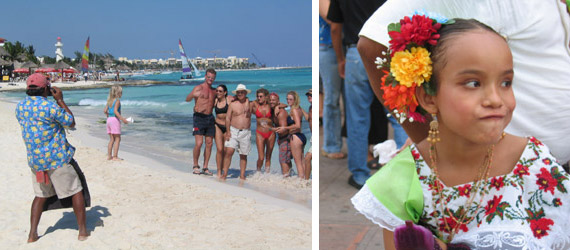|
MIRA: Multimedia Interdisciplinary Research
in Anthropology
A collaborative and comparative study of tourism destinations and
cultures
2006
Program Includes a Special Workshop on Mexican Politics
Participants will investigate Mexican Elections on July 2 including pre & post election processes in relation to tourism dynamics in Yucatán
MIRA 2005 Student
Projects, Results, Experiences, Images
MIRA
2005 Handbook, including Syllabi

MIRA in Brief
The OSEA Summer Field School is a unique research program designed for
participants to explore the rich social, cultural, historical and touristic
environments of three locations (Mérida, Playa del Carmen, and
Chichén Itzá/Pisté) in the Yucatán, México.
MIRA is “Multimedia Interdisciplinary Research in Anthropology”
and refers to the Spanish verb mirar, which means "to look"
and "to see" — mira, in the subjunctive means "Look!"
"See!" Thus, this program is centered on ways of looking and seeing
anthropologically, ethnographically, culturally, artistically, and
in developing ways to materialize practices and methodologies of visual
research, understanding and cultural production. MIRA is solidly grounded
in interdisciplinary theory, research practices, and methods to realize
research and results.
Our goal is support MIRA participants through a well-defined collaborative
research project that will contribute to one's education and yield
publishable results. Participants gain hands-on learning and experience
in visual ethnography and interdisciplinary tourism research.
CONTACT US if you would
like to be added to our mailing list for this program.
Student
Projects, Results, Experiences from MIRA 2005
| WHEN |
Summer 2006: June 27– August 12
Arrival on Tuesday June 27. Departures on Saturday, August 12
|
| WHERE |
Yucatán Peninsula of México
2006 Program includes:
—7 nights in Playa del Carmen, Jewel of the Maya Riviera
—26 nights in Mérida, the Colonial capital city
of Yucatán
—10 days in Pisté & Chichén Itzá,
the heart of Maya Civilization
|
| FORMAT |
Field
School Training Program in Interdisciplinary Research |
| WHAT |
Students receive training in interdisciplinary ethnography
and research methodologies based in intensive fieldwork participant
observation
Students design, conduct and complete independent research
projects
Special 2006 Program includes Research on Mexican Elections
on July 2
Areas of Investigation include Tourism, Urbanism, Migration,
Development, Cultural Ecology, Globalization, Performance Art,
Exhibition, Political Economy, Politics and Democracy, Election
Process and Governance, Visual Anthropology, Media Studies and
Design
|
| HOUSING |
Posadas,
hostels, and family run hotels |
| CREDITS |
8
credits in Anthropology
Courses in Visual Anthropology, Ethnographic Methods, Anthropology
of Tourism/Tourism Studies |
| LANGUAGE |
Conversational
Spanish Required. Speaking knowledge of German, Italian, French,
and Japanes is an asset to be used in individual research design |
| COST |
Program Fee covers tuition, lodging, most meals (except for
dinners and during break) for 7 days & nights in Playa del
Carmen, 26 in Mérida & 10 in Pisté; project
related transportation between these sites; planned program
excursions; and group entrance fees to archaeological sites
(program trips include Chichén Itzá and Tulum;
final scheduling may also include Coba, Ek Balam, Uxmal, and
other other Puuc Sites)
Additional costs include all personal items, consumption, and
activities; most dinners during program; lodging and food during
breaks; purchase of course materials both prior to departure
and on-site; see
details on costs
|
|